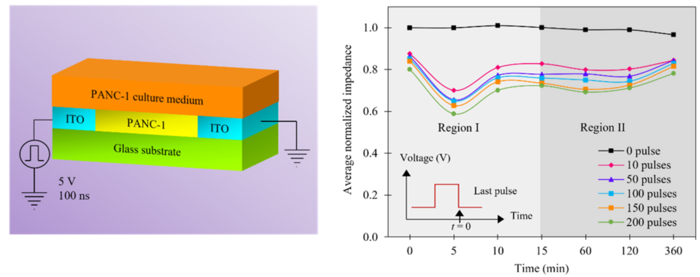SUTD researchers leverage novel nanotechnology to control cells over long periods
SUTD - Denise Lee, J Shamita Naikar, Sophia S. Y. Chan, Maria Prisca Meivita, Lunna Li, Yaw Sing Tan, Natasa Bajalovic and Desmond K. Loke
The careful introduction of cancer-related molecules into cells using precise dosage is required in cancer drug delivery. However, a challenge arises from delivering these molecules in living cells while preserving their function and viability (the number of live cells in a sample).
Nanosecond electroporation is a promising strategy to achieve excellent cell viability. Nanosecond electroporation operation, which is the application of electrical pulses in nanosecond timescales at localized regions of the cell membrane, leads to the formation of resealable pores. The cancer-related molecules are then delivered into living cells nondestructively by researchers.
A version of the nanosecond electroporation platform has been developed by researchers from the Singapore University of Technology and Design (SUTD) and A*STAR Bioinformatics Institute (BII). The platform allows pores to remain open for approximately 720 minutes, which is about 10 times longer than that achieved in current state-of-the-art electroporation systems.
Moreover, the platform shows a high electrical conductivity with an increase in number of pulses using a weak electrical voltage. This helps maintain excellent cell viability that is pivotal to applications like cancer-drug delivery and other applications.
 Schematic of the nanosecond electroporation platform (left panel) and the graph showing long recovery times (right panel).
Schematic of the nanosecond electroporation platform (left panel) and the graph showing long recovery times (right panel).
"Using this design, the time window for efficient drug delivery into cancer cells increases significantly," said SUTD Assistant Professor Desmond Loke.
Studies have shown that pore resealing is dominated by the tension of pore lines, where the opening of pores relaxes the surface tension of membranes. This increases the energy barrier for pore closure, resulting in long lived pores. The application of a high number of pulses decreases the membrane tension, which may lead to the increase in pore recovery times.
"Optimising nanosecond electroporation system performance for a wide range of applications like drug development, disease diagnostics, system biology, cell-based therapies and gene editing is the research team’s next plan," added Loke.
This research was published in Nanoscale. Other researchers involved in this work are Denise Lee, Sophia Chan, Maria Meivita, Lunna Li and Natasa Bajalovic from SUTD and Yaw-Sing Tan from BII.
Acknowledgments:
We thank K. G. Lim, L. T. Ng, A. H. Firdaus and J. Y. Koh for important discussions. The authors acknowledge support from the Singapore University of Technology and Design (SUTDT12017003), Changi General Hospital (Singapore) (CGH-SUTD-HTIF2019-001), Ministry of Education (Singapore) (MOE-T2EP50220-0022), SUTD-Zhejiang University (SUTD-ZJU (VP) 201903), and the Agency of Science Technology and Research (Singapore) (A20G9b0135) grant programs. D. K. L. acknowledges support from the Massachusetts Institute of Technology–SUTD International Design Centre and National Supercomputing Centre, Singapore (15001618). D. L. acknowledges support from the SUTD President Graduate Scholarship.
Reference:
Ultralong recovery time in nanosecond electroporation systems enabled by orientational-disordering processes , Nanoscale. (DOI: 10.1039/D1NR07362A)